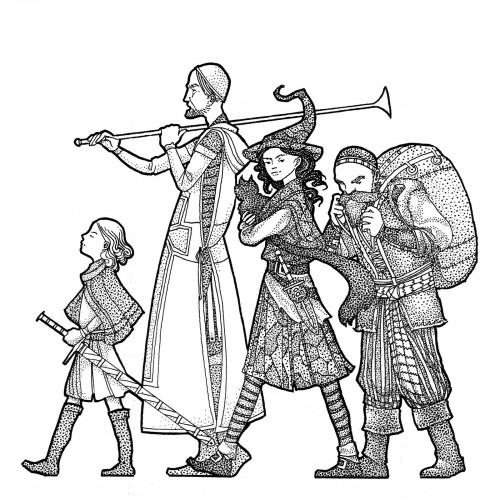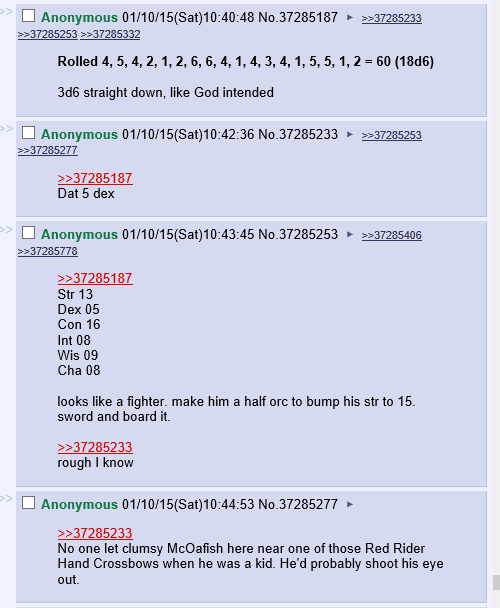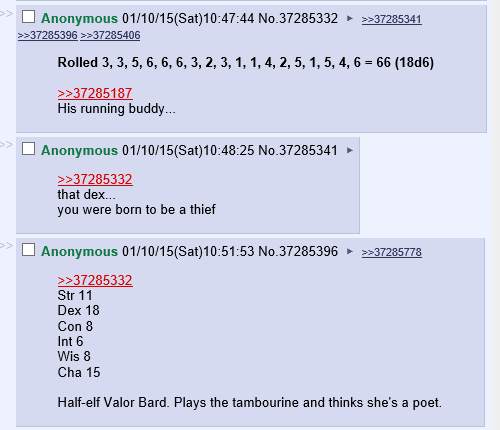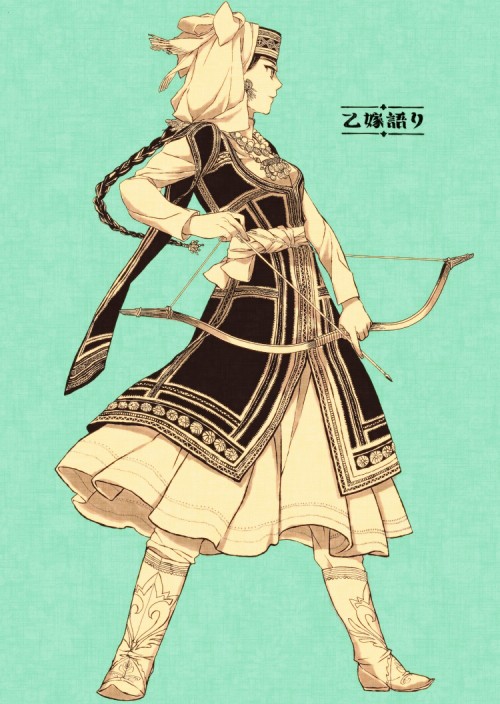In which we use 3d6-in-order and some anonymous input to start making a 4-player 5th-edition D&D party.
Yesterday on the Traditional Games section of 4chan somebody decided to go old-school and roll up a character by having the board’s random number generator give him eighteen six-sided die rolls. He took the results, in order, and declared he had produced a Half-orc Fighter. A couple of us took up the banner and rolled up some companions for him by the same process. Let’s take a look at the quick-and-dirty results, turn them into proper Type V Dungeons & Dragons characters, and consider how well or how poorly this all turned out.
Hmm. Quite tough, not remarkably strong, incredibly clumsy, not a shining light intellectually or socially. Half-orc sounds just right. This brings his statline to Str 15, Dex 5 Con 17 Int 8 Wis 9 Cha 8. Our anonymous poster wants to go Sword & Board, so we probably shouldn’t select Great Weapon Fighting, Archer, or Two-Weapon Fighting for his Fighting Style class feature. We’ll also want to think about backgrounds. He only has two stats with bonuses, one of which has no skills associated (Constitution), the other has a single skill (Athletics) which is already available to Fighters. The background could be practically anything. Let’s look at the rest of the party before committing to anything.
Okay, then. Highest-possible Dexterity. Highest Charisma that a point-buy can get you by the rules. Strength isn’t a liability. Dumb as a doorknob. Some kind of smooth-talking Rogue would be an obvious choice, but since we’re working with straight-up randomly-rolled character stats here it looks like a good opportunity to apply a well-rounded class to a lopsided pile of stats. Selecting Half-elf as a race gets us a +2 to Charisma and another +1 to invest elsewhere. Put it into Dexterity for a statline of Str 11 Dex 19 Con 8 Int 6 Wis 8 Cha 17. If we survive to get an attribute bump, we can split it between Dexterity and Charisma to get both of their bonuses up at the same time, capping off Dexterity at level 4. The poster here has specified a College of Valor Bard. First level is premature for this, but it’s hard to justify a College of Lore selection with such poor Intelligence. The tambourine is a perfect ditzy hippy chick instrument, so I don’t care if it isn’t on the equipment list in the books. The Entertainer background seems like the obvious choice. She probably met the Half-orc at a nightclub or something.
Really? An intelligent character right after the criticism of how dumb the first two were? As the person that challenged our anonymous interlocutor to roll up a smart character to balance things out, I was suspicious when I saw a 15 Intelligence on the first try. So suspicious that I checked an archive site for deleted attempts. Nope. The dice gods have smiled on our little endeavor. This character is smart, rather charming, and has low-to-poor stats otherwise. Sounds like good Wizard material. As a Human (let’s assume we use the variant rule and get a free feat) he gets +1 to two attributes of our choice. Since he’s probably going to be the brains of this operation lets invest those points in Intelligence and Wisdom. Intelligence to be good as wizardry, Wisdom to knock out the penalty to smart-guy skills like Perception and Insight. His statline is Str 10 Dex 9 Con 8 Int 16 Wis 10 Cha 13. The way he’s described by this anonymous poster, he’s a bit of a scoundrel, so I’m thinking Criminal, Charlatan, Noble, or Guild Artisan. Leaning toward Guild Artisan. He met the Fighter through the Bard, who he pursued romantically the moment he spotted her at a farmer’s market or some-such.
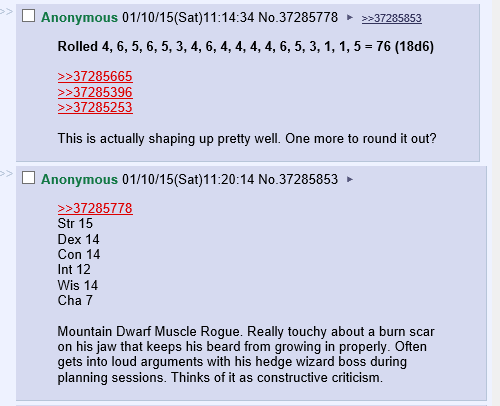
Frighteningly-good rolls by comparison, with only one properly-bad attribute. With this many good rolls it’s tempting to make a Monk or Paladin, but the poster here has selected Muscle Rogue. I’ve written about Muscle Rogues before, and am fond of this niche archetype. As a Mountain Dwarf his statline bumps to Str 17 Dex 14 Con 16 Int 12 Wis 14 Cha 7. He’s strong, he’s tough, he’s nimble enough to take full advantage of medium armor, but he’s got a personality like a cheese grater. Definitely not the boss of the party, that job stays with the Wizard, who has both the smarts and the people skills. Since we’ve had a glance at all four members of our little adventuring band, I’m inclined to have our Dwarf have a Soldier background. He knows the Fighter and Wizard from his previous professional career, and the Bard through them.
We’ve got the skeleton of an adventuring crew now. A Fighter, a Bard, a Wizard, and a Rogue. To make them work well together, they’ll need to each be reasonably good at their own jobs, compliment each others’ strengths, and mitigate each others’ shortcomings. The Fighter can do this through his Fighting Style, the Bard and Wizard through their spell selections, the Wizard has a feat selection coming to him, and all of them through their skills. The Fighter was rolled first, so we’ll start with him.
The Rogue and the Fighter are both going to be handy in a melee scrap. The Bard’s excellent Dexterity will make her dangerous with a finesse weapon like the Rapier, but her poor Constitution will leave her pretty fragile. The Wizard is also pretty fragile, and will be leading from the rear when things come to blows. Half of the group is a bit on the wimpy side and we have no dedicated healer-type, so we’ll have our Fighter pick up the Protection Fighting Style.
The Tambourine Bard is our only source of magical healing, so we want he to pick Cure Wounds as one of her first four spells. Healing Word is tempting, at the risk of becoming overly-focused. We’ll grab Faerie Fire for general combat support, instead. Dissonant Whispers is a great spell to use on a bad-guy within reach of our Muscle Rogue friend, making for a potential extra Sneak Attack. Round things out with perennial favorite Charm Person and let’s grab two cantrips. Minor Illusion and Viscious Mockery are both great go-to spells that anybody would be glad to have on-hand.
Our Scheming Boss-man Wizard has a lot of decisions to make. He knows three cantrips and six first-level spells. Eventually he’s going to be an Evoker, but that doesn’t burden his spell selection. It just speaks to his mindset. Any arcanist is well-served by knowing Detect Magic and Identify. Normally a Wizard would be happy to let his Bard companion take care of deciphering ancient runes and such, but our Half-elf friend isn’t intellectually gifted. We’ll pick up Comprehend Languages. His friends are already quite good at hurting individual opponents one at a time, so something like Burning Hands or Thunderwave would be a nice addition as crowd control. We could go with Sleep or Color Spray, both of which are file spells, but this guy’s going to be an Evoker some day, so let’s get off on the right foot. Thunderwave it is. Fragile fellow that he is, Mage Armor would be prudent. For our final first-level spell, we pick up Grease, which may have a dozen good uses in and out of combat. For cantrips we select Mage Hand, Prestidigitation, and Fire Bolt.
In our next installment, we’ll select backgrounds, personality traits, ideals, bonds, flaws, skills, and equipment.
